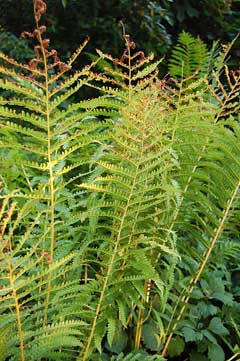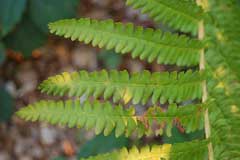 |
|
http://en.wikipedia.org/wiki/User:Ram-Man |
 |
| http://en.wikipedia.org/wiki/User:Ram-Man |
Translate this page:
Summary
Form: Upright or erect.
Physical Characteristics

 Osmunda cinnamomea is a FERN growing to 0.6 m (2ft) by 0.4 m (1ft 4in) at a medium rate.
Osmunda cinnamomea is a FERN growing to 0.6 m (2ft) by 0.4 m (1ft 4in) at a medium rate.
See above for USDA hardiness. It is hardy to UK zone 3.
Suitable for: light (sandy), medium (loamy) and heavy (clay) soils. Suitable pH: mildly acid, neutral and basic (mildly alkaline) soils and can grow in very acid soils.
It can grow in semi-shade (light woodland) or no shade. It prefers moist or wet soil.
UK Hardiness Map
US Hardiness Map
Synonyms
Plant Habitats
Woodland Garden Dappled Shade; Shady Edge; Bog Garden;
Edible Uses
Edible Parts: Leaves Shoots
Edible Uses:
The young unexpanded fronds are eaten as a nibble or cooked in soups[46, 61, 62, 116, 159, 183, 257]. The taste is said to resemble asparagus[200]. The young shoots are seen as a 'spring tonic' to cleanse the body with fresh green food after a long winter eating mainly stored foods[257]. The latent buds can be eaten in early spring, they rival chestnuts in size and flavour[95].
References More on Edible Uses
Medicinal Uses
Plants For A Future can not take any responsibility for any adverse effects from the use of plants. Always seek advice from a professional before using a plant medicinally.
Analgesic Antirheumatic Galactogogue
A decoction of the root has been rubbed into affected joints as a treatment for rheumatism[257]. The root has been chewed, a small portion swallowed and the remainder applied to a snakebite[257]. The following reports do not state which part of the plant is being used, though it is most likely that the root is being referred to. The plant is analgesic, antirheumatic and galactogogue[257]. A decoction is used internally in the treatment of headaches, joint pain, rheumatism, colds etc, and also to promote the flow of milk in a nursing mother[257].
References More on Medicinal Uses
The Bookshop: Edible Plant Books
Our Latest books on Perennial Plants For Food Forests and Permaculture Gardens in paperback or digital formats.

Edible Tropical Plants
Food Forest Plants for Hotter Conditions: 250+ Plants For Tropical Food Forests & Permaculture Gardens.
More

Edible Temperate Plants
Plants for Your Food Forest: 500 Plants for Temperate Food Forests & Permaculture Gardens.
More

More Books
PFAF have eight books available in paperback and digital formats. Browse the shop for more information.
Shop Now
Other Uses
References More on Other Uses
Cultivation details
Landscape Uses:Border, Container, Ground cover, Rock garden, Specimen, Woodland garden. Easily grown in a damp woodland or by the margins of pools and streams[187]. Likes a soil of swamp mud and loamy or fibrous peat, sand and loam[1]. Succeeds in most moist soils, preferring acid conditions[200]. Requires a constant supply of water, doing well by ponds, streams etc[1]. Plants thrive in full sun so long as there is no shortage of moisture in the soil and also in shady situations beneath shrubs etc[200]. Requires a shady position[188]. Plants are hardy to at least -20°c, they are evergreen in warm winter areas but deciduous elsewhere[200]. This species is sometimes cultivated for its edible fronds[200]. Members of this genus are rarely if ever troubled by browsing deer[233]. A very ornamental plant[1]. The rhizome is large and slowly creeping[187]. Special Features:Attractive foliage, North American native, Naturalizing, Wetlands plant, There are no flowers or blooms.
References Carbon Farming Information and Carbon Sequestration Information
Temperature Converter
Type a value in the Celsius field to convert the value to Fahrenheit:
Fahrenheit:
The PFAF Bookshop
Plants For A Future have a number of books available in paperback and digital form. Book titles include Edible Plants, Edible Perennials, Edible Trees,Edible Shrubs, Woodland Gardening, and Temperate Food Forest Plants. Our new book is Food Forest Plants For Hotter Conditions (Tropical and Sub-Tropical).
Shop Now
Plant Propagation
Spores - they very quickly lose their viability (within 3 days) and are best sown as soon as they are ripe on the surface of a humus-rich sterilized soil in a lightly shaded place in a greenhouse. Keep the compost moist, preferably by putting a plastic bag over the pot. Plants develop very rapidly, pot on small clumps of plantlets as soon as they are large enough to handle and keep humid until they are well established. Do not plant outside until the ferns are at least 2 years old. Cultivars usually come true to type[200]. Division of the rootstock in the dormant season. This is a very strenuous exercise due to the mass of wiry roots[200].
Other Names
If available other names are mentioned here
Native Range
TEMPERATE ASIA: Russian Federation (Kurile Islands, Amur, Sakhalin), China, Korea, Japan, Taiwan TROPICAL ASIA: Myanmar (north), Thailand (northeast), Vietnam NORTHERN AMERICA: Canada (Québec, Nova Scotia, Ontario, Prince Edward Island, New Brunswick, Newfoundland and Labrador), United States (Connecticut, Indiana, Maine, Massachusetts, Michigan, New Hampshire, New Jersey, New York, Ohio, Pennsylvania, Rhode Island, Vermont, West Virginia, Iowa, Minnesota, Missouri, Illinois, Oklahoma, Wisconsin, Alabama, Arkansas, Delaware, Florida, Georgia, Kentucky, Louisiana, Maryland, Mississippi, North Carolina, South Carolina, Tennessee, Virginia, Texas), Mexico (Chiapas, Oaxaca, Tabasco, Veracruz de Ignacio de la Llave) SOUTHERN AMERICA: Cuba, Jamaica, United States (Puerto Rico), Belize, Costa Rica, Guatemala, Honduras, El Salvador, Venezuela, Brazil, Colombia, Ecuador, Peru, Paraguay
Weed Potential
Right plant wrong place. We are currently updating this section.
Please note that a plant may be invasive in one area but may not in your area so it’s worth checking.
Conservation Status
IUCN Red List of Threatened Plants Status :

Growth: S = slow M = medium F = fast. Soil: L = light (sandy) M = medium H = heavy (clay). pH: A = acid N = neutral B = basic (alkaline). Shade: F = full shade S = semi-shade N = no shade. Moisture: D = dry M = Moist We = wet Wa = water.
Expert comment
Author
L.
Botanical References
43200270
Links / References
For a list of references used on this page please go here
Readers comment
| Add a comment |
|
If you have important information about this plant that may help other users please add a comment or link below. Only comments or links that are felt to be directly relevant to a plant will be included. If you think a comment/link or information contained on this page is inaccurate or misleading we would welcome your feedback at [email protected]. If you have questions about a plant please use the Forum on this website as we do not have the resources to answer questions ourselves.
* Please note: the comments by website users are not necessarily those held by PFAF and may give misleading or inaccurate information.
To leave a comment please Register or login here All comments need to be approved so will not appear immediately.
|
Subject : Osmunda cinnamomea
|
|
|
|